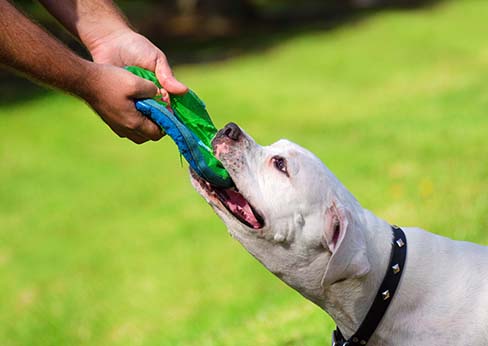In this post:
- Roughhousing
- Growling during play
- Why does my dog attack me while I am trying to exercise?
Dogs are so much fun to play with! That’s one of many reasons why we share our homes with us. They bring companionship, security, and joy to our daily lives. Playing games with our dogs can lift our spirits, give our mood a much-needed boost, or even bring a smile to our face on the worst of days.
ALWAYS supervise children playing with dogs. Accidents happen. Your dog could easily bite too hard and hurt your child. Your child might not be able to read your dog and know when the dog has reached a level of arousal that is not appropriate.
Roughhousing
There are a lot of ways people can play with their dogs, but the one that comes up for debate the most often is roughhousing. Many people ask: Should we roughhouse with dogs?
There is no easy yes or no answer to this question. It very much depends on your dog, the level of training you’ve completed with your dog, and what types of ground rules you lay down prior to roughhousing, such as:
- First, you initiate. The dog should not start until you let him know it is okay.
- Mouthing is allowed as long as he is not biting down. If he bites too hard, all play should stop. But, accidental marks will happen. However, you are in control. If you do not want any mouthing during play, you need to let your dog know by stopping the playtime.
- He needs to stop when you tell him to. If he does not, ignore him and be boring.
- Remember you control when you play and how rough you play.
- Always supervise your dog with children. They are small and accidents can happen.
- Always stop playing if your dog is being too rough for you.
- Your dog can learn how to play differently with each member of the family.
Put roughhousing on cue. This way, the dog or the puppy know when to start. This will prevent them from trying to play with just anyone. I use “Get me” or “Let’s kill this” if we also have a tug toy. It is essential that your dog does not roughhouse without you first telling him that it is okay. You control what level of arousal you will allow in your dog. If you think your dog is getting too excited or a little bit too aggressive, stop playing. You should be in control the entire time. Also, watch yourself as well. If you are starting to scare your dog, please stop playing. It is not fun for anyone at that point, and you are jeopardizing your relationship with your dog.
Growling during play
Growling and vocalizations are allowed as long as everyone is comfortable with them and your dog is not getting overly aroused.
Vetstreet.com “Dogs often growl during friendly play with other canines. This type of growling is higher-pitched and shorter in length than other growls. Watch for the proper play signals in your canine to ensure the interaction is friendly and conduct frequent breaks in play to keep arousal levels low.”
This is simply a common way that dogs express their emotions verbally. So be sure to consider their body language, facial expressions, and other behavior about the growling sound before you assume that it is hostile. For most dogs, growling is part of play – even with their pets – and not a reason to worry. However, if the dog has taken on an aggressive posture while growling, then you may wish to be concerned about a fight.
Why does my dog attack me while I am trying to exercise?
The simple answer is your dog is excited, and he thinks you are playing with him. Most of the time you are at the dog’s level (perhaps doing some crunches), and this is an opportune time for your dog to “play attack” you. You are moving funny and fast, which the dog thinks is play. If it is bothering you, ask your dog to go lay down or give them something else to play with, like a toy.
You may notice that when you engage in certain activities, especially those that bring you down to your dog’s height level, your dog attempts to engage you in play. If it is bothering you, try to redirect the dog’s play behavior into an appropriate alternative. You can ask them to go lay down somewhere with a toy. Or perhaps feed them using an interactive toy. This way your dog has something else to do, or a job, while you are doing your thing.
You could try to include your dog in your exercise. Take them on the run or hike or walk with you. Use him as your “weights” – if he is not too heavy! Teach him how to do push-ups! Take them running with you so that both of you get some exercise.
Final thoughts:
Roughhousing can be a fun way for you to connect with your dog. Just remember these simple rules: you should always initiate, you set the rules, and the dog must stop when you are done playing.





